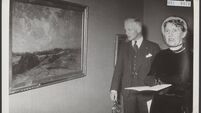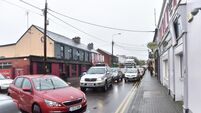Community nurses and home helps show how to run a health service
And God knows I’m not the only critic. It seems that hardly a week goes by without a report that highlights serious deficiencies in the way the system is financed, resourced and managed, about secrecy and a lack of accountability, about priorities and the gap – often huge – between policy and implementation.
But you know something? In fact, do you know what the real tragedy is? The real tragedy is that there is so much about the HSE that works, and works really well. Especially when you come into contact with our health and social service systems on the ground, there is a huge amount to admire.
Let me give you one small example. I recently had occasion to spend about 10 days going in and out of a fairly small Irish hospital because of a family illness. The patient in question was very seriously ill and I suppose it would be fair to say that, apart from the seriousness of her illness, she wouldn’t be an easy patient.
And the hospital in question (I’m not going to name it) was a bit of a dump. Portable buildings merged with old Victorian buildings and some modern extensions in the sort of mish-mash that would drive an architect crazy. It was almost impossible to keep clean – holes in walls, cracked lino, old paint, cheap furniture. Months after the swine flu “epidemic” had passed there were still signs up everywhere saying you weren’t wanted if you were sneezing.
But the care that hospital delivered was fantastic. Every member of staff I encountered – consultants, junior doctors, nurses, ward orderlies, cleaners, kitchen and canteen staff – was hard-working, understanding and extremely professional. What’s more they made time to answer questions and provide as much information as they could.
Like all Irish hospitals, admission was through an interminable procedure in the casualty department, but once admission was organised, you wouldn’t get a better standard of care anywhere. I got a strong sense that the clapped-out nature of the building and the financial pressures the hospital was working under meant that everyone was delivering care against the odds. But deliver it they did.
Over recent years too I’ve come to learn a lot about, and be grateful for, the home help service delivered by the HSE. Again, it’s a service that is delivered, as far as I can tell, on a shoestring. It goes a long way towards enabling the continued independence of elderly people and, because it does, it saves the state an absolute fortune.
But home helps are poorly paid and they have no career structure.
It’s one of those services that always seems to be in the frontline for cuts when money has to be saved. As a result, it’s a service that entirely depends on the quality of the women it employs. In my observation, they are fantastic. They deliver a lot, and they put up with a lot, with quiet and unassuming grace. It would repay all of us 10 times over to develop that service to the point where it became an automatic response to situations of need.
Another frontline service that goes largely unheralded, and yet delivers an astonishingly professional public service, is community nursing. There are several thousand community nurses and public health nurses in Ireland providing services to young mothers, to people with intellectual disability, to elderly people and to their families.
It’s one of those grades in the health service about which you never hear a great deal – that’s essentially because they do great work under the radar.
In fact the community nurse, in addition to being right at the leading edge of primary care, ought to be one of the main sources of preventative care in Ireland. At a time, for example, when there is so much emphasis on child protection, it’s astonishing that public health nurses aren’t more fully integrated into the family support system.
Every young mum in Ireland is supposed to get a visit from a community nurse within 48 hours of leaving hospital (and they do), and five visits altogether in the first couple of years of their babies’ lives.
Those visits add up to an enormous treasure trove of professional information. We actually know, because our public health nurses know, how well every baby and toddler is doing. What that means is that public health nurses aren’t just providing a huge amount of therapeutic support, they’re also a kind of walking early warning system.
If non-accidental injuries are happening to a child, or an elderly person seems more frightened and anxious, the public health nurse’s antennae will usually be active immediately.
But guess what – and you won’t be too surprised at this – there is no system for collating and sharing the information they collect. There isn’t even what’s called a common assessment standard, so that every public health nurse gathers data the same way. They carry out their assessments and they prepare their reports – but then they don’t go anywhere.
It is absurd that public health nurses, all of them highly qualified, aren’t seen as essential cogs in the wheel of preventative services. In fact it seems sometimes as if they aren’t taken seriously at all.
I’ve seen other elements of the health system at work too. Many of the smaller voluntary organisations that are funded by the HSE work astonishingly well. They deliver value for money, and they deliver quality and imagination. Because, in many cases, the smaller organisations are much closer to the people they serve, their relationships and their response times are much better than you could ever expect from a large impersonal bureaucracy.
THAT has been especially true in my experience of the agencies that work with people affected by some of the revelations of recent years. In the aftermath of the Ryan and Murphy reports, for instance, organisations like the Dublin Rape Crisis Centre, the Rape Crisis Networks and One in Four were all inundated with requests for help from people who had been deeply traumatised. They are all organisations that work on a shoestring (at least in terms of the demands they make on the public purse), but they have responded magnificently and probably saved lives in the process.
I’m guessing each of us could give different examples from our own direct experience. I’m guessing too that the thing all these good examples have in common is a sense of being rooted in the community.
It mightn’t be too surprising to discover that the best bits of the healthcare system are those that are managed locally and respond to local needs, and those that are small enough to be personal.
But maybe, just maybe, that’s where we have gone wrong. Sure, there are some services that require a certain amount of scale to be effective – we’re never going to have a neurological specialty in every county. Small and local actually delivers the goods, and the experiment in centralising everything simply hasn’t worked. It has turned what ought to be our health service into a health bureaucracy that serves itself.
Isn’t it time to think it out again?















